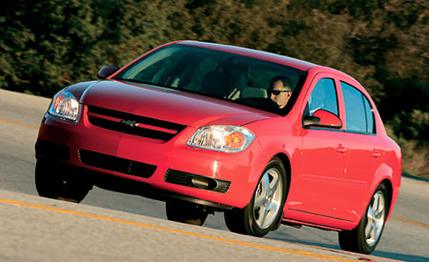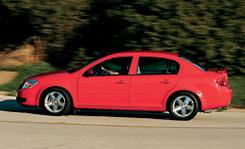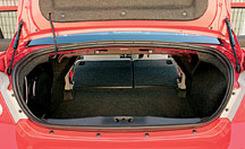
 Road Test
Road Test
Those who pray to a higher power for the revival of General Motors should note that in many religions the savior prefers to arrive in plain dress. The new Chevrolet Cobalt has ho-hum written all over it, but nothing on sale in a GM dealership today bodes better for the outlook of the world's largest automaker. The Cobalt sparks no revolution, doesn't scare small children, and won't set hallowed historical figures spinning in their graves. All it does is quietly--very quietly and serenely--prove that when GM decides to build an accomplished small car, it can.
It had better be good, this Cobalt.
For starters, we've waited decades for its arrival. The Cobalt's predecessor, the Chevy Cavalier, was born on the same day as dirt. The first ones clattered out of dealerships in 1981. Over the Cavalier's lifetime, Toyota put its Corolla through five redesigns, while this small, strong-selling Chevrolet got mostly minor makeovers and powertrain tweaks.
Cobalt pricing puts its nose right in the feedbag of league thoroughbreds such as the Corolla. The field-stripped Cobalt sedan starts at $14,190, and $16,485 buys a mid-level LS with aluminum wheels, ABS, and power windows and locks (the LS featured here is $18,245 with an automatic trans, the Preferred Equipment Group, and a thumping Pioneer stereo). These prices shadow those of the Corolla and Honda Civic. The Cobalt plays in the same sandbox as Scions, the Ford Focus, and formidable brand-Bs from Korea such as the Hyundai Elantra, which finished a laudable second in our last roundup of bargain cars ["Double-Dip Dreamboats," C/D , November 2002].
Sure, the difference between what GM demands and what GM gets after feverish discounting pays a mortgage. At the time of this writing, Los Angeles-area dealers were already ballyhooing a $1500 rebate on the Cobalt. That brings up another long-term mission of the car: Convince buyers to maybe, eventually, someday pay an actual sticker price for a Chevrolet because, like a Toyota, it's just that good.

 Is the Cobalt that good? For GM, it's miraculous, even more so considering this is the same pan-global architecture--called Delta in lingua-GM--underpinning the Saturn Ion. In January 2003 we vented three or four spleens on the cheaped-out, noisy, decidedly unfun Ion. Former technical director Frank Markus's words, "most disappointing all-new American car in a decade," echoed in the halls of GM for some time, we are told.
Is the Cobalt that good? For GM, it's miraculous, even more so considering this is the same pan-global architecture--called Delta in lingua-GM--underpinning the Saturn Ion. In January 2003 we vented three or four spleens on the cheaped-out, noisy, decidedly unfun Ion. Former technical director Frank Markus's words, "most disappointing all-new American car in a decade," echoed in the halls of GM for some time, we are told.
It takes just five minutes of driving to learn that the Cobalt works harder for your love. Your eyes fall on a dashboard where the plastic panels merge as a seamless, flush-finished unit. No jagged part lines or glaring gaps to signify where the nickels were squeezed out. Your fingers feel, well, almost nothing of the vibrations generated by the engine or road blight. They are absorbed by a stiffened structure and better-isolated suspension. Even approaching the 6500-rpm shift point, your ears hear just a distant thrum from the engine room, its noise damped by specially molded acoustical pads, doubled-up door seals, and sheets of multilayer Quiet Steel--all of which were added to the Cobalt after lessons learned on the Ion.

 The Cobalt has rental-unit styling, but buyers shopping the budget aisle of the dealership generally want more practicality than pizazz. Open the trunk to see practicality personified. There are 14 cubic feet in there, a smidge more than in the Civic. Where the Ion eats space with intrusive gooseneck hinges, the Cobalt has multilink trunk supports that pack flat and swing the lid farther forward to avoid cranial collisions.
The Cobalt has rental-unit styling, but buyers shopping the budget aisle of the dealership generally want more practicality than pizazz. Open the trunk to see practicality personified. There are 14 cubic feet in there, a smidge more than in the Civic. Where the Ion eats space with intrusive gooseneck hinges, the Cobalt has multilink trunk supports that pack flat and swing the lid farther forward to avoid cranial collisions.
Pull the twin handles in the trunk to release each side of the 60/40-split rear seatbacks. The outboard headrests (the center seat does without) cleverly mount to the parcel shelf, so the seatbacks tuck down without having to first pry off headrests. The bottom cushion is fixed in place so the extended load floor isn't flat, but the opening is plenty roomy for monthly runs to the buy-in-bulk warehouse.